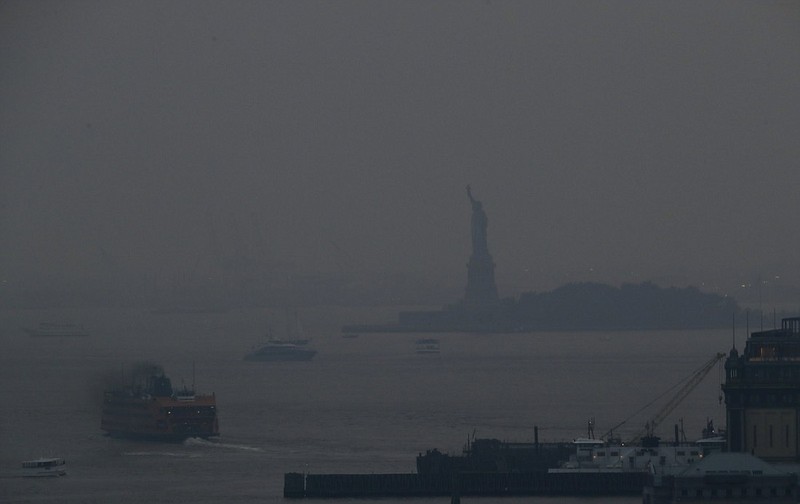PORTLAND, Ore. (AP) - Smoke and ash from massive wildfires in the American West shrouded the sky and led to air quality alerts on parts of the East Coast on Wednesday as the effects of the blazes were felt 2,500 miles (4,023 kilometers) away.
Haze hung over New York City, New Jersey and Pennsylvania as strong winds blew smoke east from California, Oregon, Montana and other states on the opposite end of the country.
The nation's largest wildfire, Oregon's Bootleg Fire, grew to 616 square miles (1,595 square kilometers) - just over half the size of Rhode Island. Fires also burned on both sides of California's Sierra Nevada, Washington state and other areas of the West.
The smoke blowing in to the East Coast was reminiscent of last fall, when large blazes burning in Oregon's worst wildfire season in recent memory choked the local sky with pea-soup smoke but also affected air quality several thousand miles away. So far this year, Seattle and Portland have largely been spared the foul air as the weather and winds push the smoke east.
People in parts of New Jersey, Pennsylvania and elsewhere with health issues like heart disease and asthma were told to avoid the outdoors. Air quality alerts for parts of the region were in place through Thursday.
"We're seeing lots of fires producing a tremendous amount of smoke, and ... by the time that smoke gets to the eastern portion of the country where it's usually thinned out, there's just so much smoke in the atmosphere from all these fires that it's still pretty thick," said David Lawrence, a meteorologist with the National Weather Service. "Over the last two years, we've seen this phenomenon."
The Oregon fire has ravaged the sparsely populated southern part of the state and has been expanding by up to 4 miles (6 kilometers) a day, pushed by gusting winds and critically dry weather that's turned trees and undergrowth into a tinderbox.
Fire crews have had to retreat from the flames for 10 consecutive days as fireballs jump from treetop to treetop, trees explode, embers fly ahead of the fire to start new blazes and, in some cases, the inferno's heat creates its own weather of shifting winds and dry lightning. Monstrous clouds of smoke and ash have risen up to 6 miles (10 kilometers) into the sky and are visible for more than 100 air miles (161 kilometers).
Authorities in Oregon said lower winds and temperatures Tuesday allowed crews to improve fire lines, and they hoped to make more progress Wednesday. The fire was approaching an old burn area on its active southeastern flank, raising hopes it would not spread as much.
The blaze, which is being fought by more than 2,200 people, is about one-third contained. It was within a few hundred acres of becoming Oregon's third-largest wildfire in modern history.
At least 2,000 homes have been evacuated at some point during the fire and an additional 5,000 threatened. At least 70 homes and more than 100 outbuildings have burned, but no one is known to have died. Thick smoke hangs over the area where residents and wildlife alike have been dealing with months of drought and extreme heat.
Extremely dry conditions and recent heat waves tied to climate change have made wildfires harder to fight. Climate change has made the West much warmer and drier in the past 30 years and will continue to make weather more extreme and wildfires more frequent and destructive.
